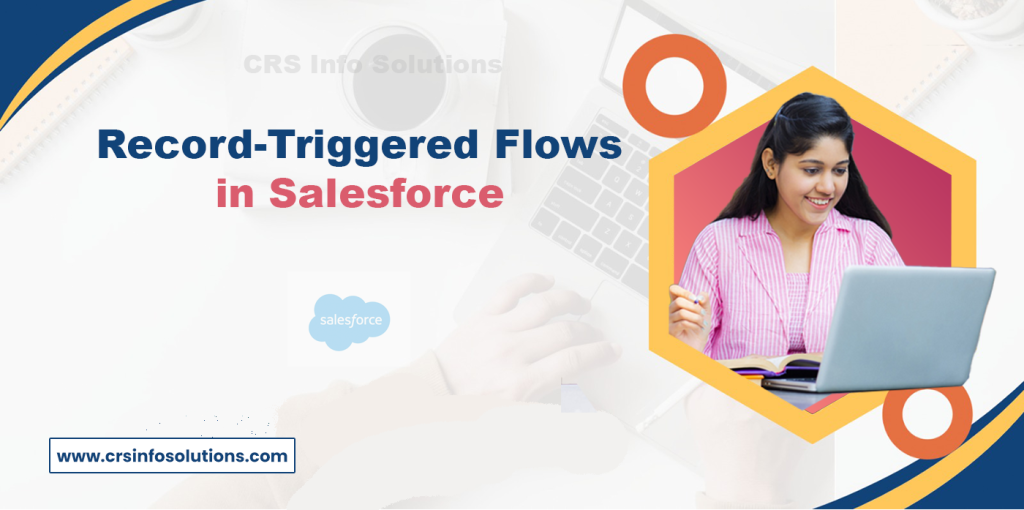
Record-Triggered Flows in Salesforce

What are Record-Triggered Flows?
Record-Triggered Flows in Salesforce are automated processes that are initiated when a Salesforce record is created, updated, or deleted. These flows are particularly effective for automating routine tasks, enforcing business rules, and ensuring data consistency across Salesforce objects without manual intervention.
Examples of Record-Triggered Flows in Salesforce
Automatic Case Assignment:
Scenario: A customer support team uses Salesforce to manage service cases.
Flow Implementation: A Record-Triggered Flow can be set up to automatically assign new cases to the appropriate support team based on the case category. When a new case record is created, the Flow checks the case category (e.g., Technical, Billing) and updates the case assignment field with the team best suited to handle that category.
Opportunity Stage Progression Notifications:
Scenario: A sales team wants to track the progression of sales opportunities.
Flow Implementation: This flow triggers whenever the stage of an opportunity is updated. If the opportunity moves to a critical stage, like ‘Proposal Sent’ or ‘Negotiation’, the Flow can automatically send notification emails to key stakeholders, such as the sales manager or the account team, keeping them informed about important developments.
Lead Scoring and Qualification:
Scenario: Marketing and sales teams need to score and qualify leads.
Flow Implementation: When a new lead is entered into Salesforce, a Record-Triggered Flow calculates a lead score based on certain criteria such as industry, company size, and engagement level. If the lead score exceeds a predefined threshold, the lead is marked as qualified and assigned to a sales representative for follow-up.
Automated Invoice Generation:
Scenario: A company wants to automate its invoicing process.
Flow Implementation: Upon closing a deal, marked by the update of an opportunity to ‘Closed Won’, the Flow triggers the creation of an invoice record. This record can include relevant opportunity details such as customer information, products or services sold, and pricing. The invoice can then be automatically sent to the accounting team for processing.
Employee Offboarding:
Scenario: HR needs to manage offboarding processes for departing employees.
Flow Implementation: When an employee record is updated to reflect their departure (e.g., setting an ‘End Date’), the Flow can initiate offboarding tasks. This could include revoking system access, initiating exit interviews, and updating payroll status. The Flow ensures that all necessary steps are taken in a consistent and timely manner.
Frequently Asked Questions (FAQs)
What are Record-Triggered Flows in Salesforce?
Record-Triggered Flows in Salesforce are a type of automation that is triggered automatically when a record is created, updated, or deleted. These flows allow you to build complex business logic without writing code. They can be configured to run immediately after a record change or scheduled to run at a specified time after the change.
How do you create a Record-Triggered Flow in Salesforce?
To create a Record-Triggered Flow in Salesforce, follow these steps:
- Navigate to Setup and search for Flows.
- Click New Flow and select Record-Triggered Flow.
- Choose the object on which the flow will trigger and define the criteria for triggering.
- Configure the actions that should occur when the flow is triggered, such as updating records, sending emails, or calling Apex classes.
- Save and activate the flow.
What are the considerations for using Record-Triggered Flows in Salesforce?
When using Record-Triggered Flows in Salesforce, consider the following:
- Performance: Ensure that the flow does not negatively impact performance, especially if it processes a large number of records.
- Order of Execution: Be aware of the order of execution in Salesforce, as Record-Triggered Flows run before other automation like workflows and processes.
- Governor Limits: Record-Triggered Flows are subject to Salesforce governor limits, so design them efficiently to avoid hitting these limits.
- Testing: Thoroughly test your flows in a sandbox environment to ensure they work as expected and do not introduce any unintended consequences.
Record-Triggered Flows in Salesforce offer a powerful way to automate processes in response to record changes, enhancing operational efficiency and accuracy. These examples demonstrate the versatility of Record-Triggered Flows in managing various business scenarios, from customer service to sales and HR processes. By automating routine tasks and enforcing business rules, these flows help organizations streamline their workflows and maintain data integrity within the Salesforce platform.
For those looking for Salesforce learning, CRS Info Solutions provides an extensive Salesforce training program designed to enhance your skills and career opportunities. Explore our Salesforce training in India to gain practical, hands-on experience.

